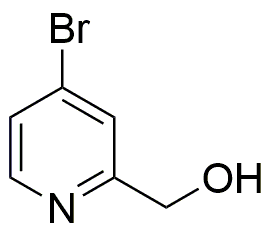4-Bromo-2-pyridinemethanol is widely utilized in research focused on:
- Pharmaceutical Development: This compound serves as a key intermediate in the synthesis of various pharmaceuticals, particularly those targeting neurological disorders. Its unique structure allows for the development of drugs with enhanced efficacy.
- Agricultural Chemicals: It is used in formulating agrochemicals, including pesticides and herbicides, due to its ability to interact with biological systems, providing effective solutions for crop protection.
- Material Science: The compound is explored in the development of advanced materials, such as polymers and coatings, where its bromine substituent contributes to improved thermal and chemical resistance.
- Biochemical Research: Researchers utilize it as a tool in studying enzyme interactions and metabolic pathways, aiding in the understanding of various biological processes.
- Analytical Chemistry: It is employed as a standard in analytical methods, helping to calibrate instruments and validate techniques for detecting similar compounds in complex mixtures.
General Information
Properties
Safety and Regulations
Applications
4-Bromo-2-pyridinemethanol is widely utilized in research focused on:
- Pharmaceutical Development: This compound serves as a key intermediate in the synthesis of various pharmaceuticals, particularly those targeting neurological disorders. Its unique structure allows for the development of drugs with enhanced efficacy.
- Agricultural Chemicals: It is used in formulating agrochemicals, including pesticides and herbicides, due to its ability to interact with biological systems, providing effective solutions for crop protection.
- Material Science: The compound is explored in the development of advanced materials, such as polymers and coatings, where its bromine substituent contributes to improved thermal and chemical resistance.
- Biochemical Research: Researchers utilize it as a tool in studying enzyme interactions and metabolic pathways, aiding in the understanding of various biological processes.
- Analytical Chemistry: It is employed as a standard in analytical methods, helping to calibrate instruments and validate techniques for detecting similar compounds in complex mixtures.
Documents
Safety Data Sheets (SDS)
The SDS provides comprehensive safety information on handling, storage, and disposal of the product.
Product Specification (PS)
The PS provides a comprehensive breakdown of the product’s properties, including chemical composition, physical state, purity, and storage requirements. It also details acceptable quality ranges and the product's intended applications.
Certificates of Analysis (COA)
Search for Certificates of Analysis (COA) by entering the products Lot Number. Lot and Batch Numbers can be found on a product’s label following the words ‘Lot’ or ‘Batch’.
Número de catálogo
Número de lote/lote
Certificates Of Origin (COO)
This COO confirms the country where the product was manufactured, and also details the materials and components used in it and whether it is derived from natural, synthetic, or other specific sources. This certificate may be required for customs, trade, and regulatory compliance.
Número de catálogo
Número de lote/lote
Safety Data Sheets (SDS)
The SDS provides comprehensive safety information on handling, storage, and disposal of the product.
DownloadProduct Specification (PS)
The PS provides a comprehensive breakdown of the product’s properties, including chemical composition, physical state, purity, and storage requirements. It also details acceptable quality ranges and the product's intended applications.
DownloadCertificates of Analysis (COA)
Search for Certificates of Analysis (COA) by entering the products Lot Number. Lot and Batch Numbers can be found on a product’s label following the words ‘Lot’ or ‘Batch’.
Número de catálogo
Número de lote/lote
Certificates Of Origin (COO)
This COO confirms the country where the product was manufactured, and also details the materials and components used in it and whether it is derived from natural, synthetic, or other specific sources. This certificate may be required for customs, trade, and regulatory compliance.


